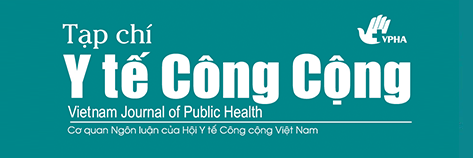Kiến thức, thực hành dinh dưỡng của bà mẹ có con dưới 5 tuổi người H’mông tại một số xã thuộc huyện Bảo Lạc, tỉnh Cao Bằng năm 2014 (Knowledge and practice in nutrition of H’mong mothers in some communes of Bao Lac district, Cao Bang province, 2014)
Tóm tắt
Kiến thức, thực hành dinh dưỡng của phụ nữ trong thời kỳ mang thai và cho con bú có vai trò quan trọng đối với sức khỏe của trẻ nhỏ. Mục tiêu: mô tả kiến thức, thực hành dinh dưỡng của bà mẹ người H’Mông. Phương pháp: 144 bà mẹ 15-49 tuổi, tại 4 xã thuộc huyện Bảo Lạc, tỉnh Cao Bằng được lựa chọn và phỏng vấn bằng bộ câu hỏi thiết kế sẵn. Kết quả: Khi mang thai, 13,9% đối tượng ăn nhiều hơn so với khi chưa mang thai, 97,2% không uống sữa, 20,8% uống viên sắt/acid folic, 55,6% không biết số lần cần khám thai. Sau khi sinh, 97,9% bà mẹ cho trẻ bú sữa mẹ trong vòng 1 giờ sau sinh, 100% đối tượng chưa hiểu về sữa non, tỷ lệ bú sữa mẹ hoàn toàn trong 6 tháng đầu là 39,6%, 32,6% không biết thời điểm nên cho trẻ ăn bổ sung. Kết luận: Bà mẹ người H’Mông thiếu hiểu biết về sữa non, số lần cần khám thai, thời điểm cho trẻ ăn bổ sung, tỷ lệ uống sắt/acid folic khi mang thai thấp. Cần tiến hành truyền thông, giáo dục dinh dưỡng để nâng cao kiến thức, thực hành dinh dưỡng cho nhóm đối tượng này.
English abstract:
Knowledge and practice in nutrition of pregnant women and lactating mothers play an important role for the child’s health. Aims: to describe knowledge, practice in nutrition of H’Mong mothers. Methods: 144 mothers aged 15-49 years, from 4 communes in Bao Lac district, Cao Bang province, were selected and interviewed using the structured questionnaire. Results: During pregnancy, 13.9% of subjects consumed more food compared to non-pregnant time; 97.2% did not drink any kind of milk; 20.8% took iron/folic acid supplements; and 55.6% did not know the number of antenatal visits. After birth, 97.9% of subjects initiated breastfeeding within one hour of birth; all subjects did not know about the colostrum; the prevalence of exclusive breastfeeding for 6 months was 39.6%; and 32.6% of subjects did not know when complementary foods should be given to the child. Conclusions: H’Mong mothers lack understanding about the colostrum, the minimum number of antenatal visits, the appropriate timing of complementary feeding, and the prevalence of iron/folic acid supplements consumption is low. Nutrition education and communication is needed to improve the knowledge, practice in nutrition for this target group.
Từ khóa
Toàn văn:
PDF (English)##submission.citations##
Tiếng Việt
Bộ Y tế - Viện Dinh dưỡng (2012). Chiến lược Quốc gia về Dinh dưỡng giai đoạn 2011-2020 và tầm nhìn đến năm 2030. Nhà xuất bản Y học Hà Nội.
Bộ Y tế - Viện Dinh dưỡng (2015). Thông cáo báo chí ngày Vi chất dinh dưỡng (1-2/6/2015). [Internet] [trích dẫn ngày 20 tháng 7 năm 2015]. Lấy từ: URL: http://viendinhduong.vn/news/vi/777/12/thong-cao-bao-chi-ngay-vi-chat-dinh-duong-1-262015.aspx.
Lê Thị Hợp (2012). Nhu cầu dinh dưỡng khuyến nghị cho người Việt Nam. Nhà xuất bản Y học, Hà Nội.
Phan Bích Nga (2012). Thiếu vi chất dinh dưỡng ở mẹ và con và hiệu quả bổ sung đa vi chất trên trẻ suy dinh dưỡng bào thai tại bệnh viện phụ sản trung ương. Luận án tiến sỹ dinh dưỡng, Viện Dinh dưỡng, Hà Nội.
Tiếng Anh
Casey CE, Neifert M R, Seacat JM and Neville MC (1986). "Nutrient intake by breast-fed infants during the first five days after birth". Am J Dis Child, 140 (9): 933-6.
Centers for Disease Control and Prevention (2013). "Progress in Increasing Breastfeeding and Reducing Racial/Ethnic Differences - United States, 2000-2008 Births. Morbidity and Mortality Weekly Report". 62 (5): 77-90.
Haas JD, Murdoch S, Rivera J and Martorell R (1996). "Early nutrition and later physical work capacity". Nutr Rev, 54 (2 Pt 2): S41-8.
Jones G, Steketee RW, Black RE, Bhutta ZA and Morris SS (2003). "How many child deaths can we prevent this year?". Lancet, 362 (9377): 65-71.
Martin RM, Smith GD, Frankel S and Gunnell D (2004). "Parents' growth in childhood and the birth weight of their offspring". Epidemiology, 15 (3): 308-16.
Martorell R, Kettel Khan L and Schroeder DG (1994). "Reversibility of stunting: epidemiological fidings in children from developing countries". Eur J Clin Nutr, 58 (Suppl.1): S45-S57.
Minzu University of China (2010). "Study on Traditional Beliefs and Practices regarding Maternal and Child Health in Yunnan, Guizhou, Qinghai and Tibet". 29-34.
Pollitt E, Gorman KS, Engle PL, Rivera JA and Martorell R (1995). "Nutrition in early life and the fulfillment of intellectual potential". J Nutr, 125 (4 Suppl): 1111S-1118S.
UNICEF, WHO and UNU (2012). Composition of a multi-micronutrient supplement to be used in pilot programmes among pregnant women in developing countries: report of a United Nations Children’s Fund (UNICEF), World Health Organization (WHO), United Nations University (UNU) workshop held at UNICEF Headquarters, New York, July 9, 1999, New York, United Nations Children’s Fund, 2000. [Internet] [cited 1 December 2012]. Available from: URL: http://apps.who.int/iris/handle/10665/75358.
US Department of Health and Human Services (2011). Healthy People 2020 Objectives. [Internet] [cited 1 June 2011]. Available from: URL: http:// healthypeople.gov/2020/topicsobjectives2020/pdfs/HP2020objectives.pdf.
WHO and UNICEF (2009). Baby-friendly hospital initiative: revised, updated and expanded for integrated care. Geneva, World Health Organization and UNICEF.
WHO (2002). WHO antenatal care randomized trial: manual for the implementation of the new model. Geneva, World Health Organization.
WHO (2012). Guideline: Daily iron and folic acid supplementation in pregnant women. Geneva, World Health Organization.
WHO (2009). WHO Global Data Bank on Infant and Young Child Feeding. Geneva, World Health Organization.
WHO (2011). Guideline: Vitamin A supplementation in pospartum women. Geneva, World Health Organization.



